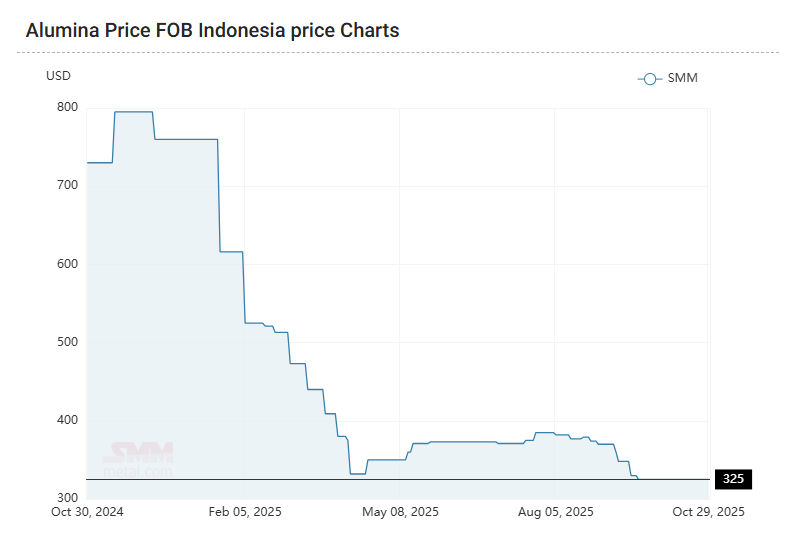

Historic Price Trends and Current Market Position: The latest market data shows alumina FOB Indonesia at USD 325 per metric ton, compared to the SMM Alumina Index for China at USD 357.34 per metric ton, creating a USD 32.34 per ton price differential that favours Indonesian exporters. This pricing represents a dramatic transformation from the previous year, with a 55.48 per cent year-on-year decrease from October 2024’s USD 730 per metric ton. The current price trend reveals an accelerated downward movement, with the current October price marking a 12.16 per cent decrease from early September's USD 370 per metric ton. This follows a month-on-month decline from August to September, indicating rapid market adjustments that have strengthened Indonesia's export positioning.

Figure 1: Alumina FOB Indonesia Price Trend (1-Year View)
29 Oct 2024 – 29 Oct 2025 | Source: SMM (Shanghai Metals Market)
Key Price Levels (from chart):
→ -59.12 per cent from Nov peak | -55.48 per cent y-o-y | -12.16 per cent from early Sep
The current price trend reveals an accelerated downward movement, with October 2025 marking a 12.16 per cent decline from early September 2024’s ~USD 370 per metric ton. This follows a month-on-month decline from August to September, signalling rapid market adjustments that have strengthened Indonesia’s export positioning.
Factors Driving the Price Trend
Several structural forces are reshaping the global alumina market:
Major Production Expansion Underway
The Indonesian alumina sector is witnessing simultaneous expansion across multiple major projects:
|
Project |
Status |
Capacity Addition |
Timeline |
|
PT Bintan Alumina Indonesia (BAI) |
Expansion Approved |
1 million tpa |
2025 |
|
PT Borneo Alumina Indonesia |
Commissioning Started |
Full Plant |
2025 |
|
PT Borneo Alumindo Prima |
Phase 1 Construction |
1 million tpa |
Completion 2025 |
PT Bintan Alumina Indonesia (PT BAI) is advancing plans to increase its production capacity by 1 million tons per annum in 2025, representing one of the most significant single expansions in the country's alumina history. This expansion comes as the company seeks to capitalise on Indonesia's strategic position in the global market.
Meanwhile, PT Borneo Alumina Indonesia has reached a crucial milestone, having begun commissioning operations in the fourth quarter of 2024. The company is targeted to achieve full operational status by the first quarter of 2025, adding substantial new capacity to Indonesia's production profile.
Complementing these developments, PT Borneo Alumindo Prima is progressing with its construction phase, with the 1,000,000-ton phase one facility expected to be completed by 2025. Although the commissioning timeline remains unconfirmed, the project represents another critical component of Indonesia's comprehensive capacity expansion strategy.
Factors Driving Market Transformation
The convergence of policy, investment, and timing is reshaping the industry:
Export Opportunities and Competitive Advantages
The simultaneous increase in production capacity and competitive pricing creates multiple opportunities for Indonesian exporters. The significant price advantage, currently USD 32.34 per ton below Chinese benchmarks, makes Indonesian alumina particularly attractive to price-sensitive markets across Asia, including Japan, South Korea, and India.
The geographical advantage of Indonesian suppliers provides an additional competitive edge, with proximity to major Asian markets that might reduce shipping costs and delivery times. This logistics benefit becomes increasingly valuable as global shipping costs remain volatile and supply chain reliability grows in importance.
Planned production increases could position Indonesia to capture market share from traditional suppliers in Australia and other established producing regions. The scale of the expansions, totalling several million tons annually when all projects reach full capacity, represents a substantial addition to global supply.
Market Considerations
Despite the momentum, challenges remain:
Future Outlook and Global Implications
Indonesia's production expansion could significantly impact global alumina trade patterns. The combination of competitive pricing and increased supply availability may create sustained pressure on global benchmarks, potentially leading to a structural adjustment in regional pricing differentials.
The successful implementation of these expansion plans could elevate Indonesia to the ranks of major global alumina exporters, fundamentally altering the global supply landscape. Beyond immediate export revenues, the growth of the alumina sector supports the development of technical expertise and industrial infrastructure that could facilitate future moves into aluminium smelting and other downstream activities.
Indonesian producers should focus on building diversified market relationships and developing a reputation for reliability and quality consistency. These factors will help sustain export growth even when pure price advantages diminish or market conditions change.
The coming quarters will be critical for assessing how effectively Indonesia can translate its production expansion and current price advantage into a sustainable market position. Export volume data through 2025 and into 2026 will provide clearer indicators of the sector's ability to compete effectively in the global alumina marketplace.
As the market continues to evolve, stakeholders across the value chain are closely monitoring how Indonesian producers manage the simultaneous challenges of rapid expansion, quality assurance, and market development in an increasingly competitive global environment.
Recommendation to Producers:
Focus on quality certification, diversified offtake, and logistics partnerships to lock in market share beyond the current price cycle.
Key Monitoring Points (2025–2026)
|
Metric |
Impact |
|
Export volume data |
Proof of market capture |
|
New plant ramp-up schedules |
Supply reliability |
|
China's demand recovery |
Risk of price rebound |
|
Freight & port throughput |
Logistics ceiling |
Note: This article has been issued by SMM and has been published by AL Circle with its original information without any modifications or edits to the core subject/data.
Responses








